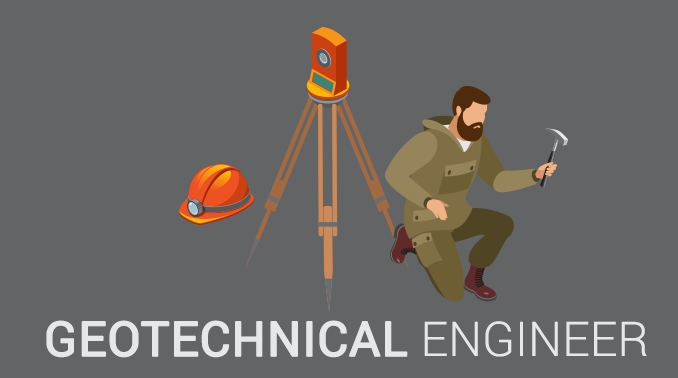Getting My Geotheta To Work
Getting My Geotheta To Work
Blog Article
The Best Guide To Geotheta
Table of ContentsThe Facts About Geotheta UncoveredThe Definitive Guide to GeothetaWhat Does Geotheta Mean?The Greatest Guide To Geotheta
They collaborate with civil designers, architectural designers, engineers, and various other experts to incorporate geotechnical considerations right into the general task design and construction procedure. This needs effective team effort, sychronisation, and interaction to ensure that the geotechnical aspects line up with the project objectives and meet regulatory needs.Mining & Products Design: Principles of boring, infiltration prices, and aspects impacting the choice of boring technique. Qualities of dynamites, firing systems and blast patterns. Blasting strategies in surface area and below ground workings. Unique blowing up methods at excavation borders. Vibration and sound control. Mechanical and continuous methods to fragmentation, consisting of longwall shearing and fullface boring.
Modelling of piece and particle dimension distributions; comminution as a transfer function. Comminution innovation: squashing, grinding, dimension category. Integrated evaluation of fragmentation and comminution operations. Used by: Mining & Products Design.
Our Geotheta Statements
Bachelor's level programs in civil, geotechnical, geological, and environmental engineering generally last four years and include basic education and learning courses in English, social scientific research, and the liberal arts, along with training courses in advanced mathematics, structural geology, and liquid mineralogy. (https://disqus.com/by/geotheta/about/)
Geotechnical design involves the evaluation of the soil and rock conditions at a certain site, and their ramifications for the advancement of that site. As most frameworks depend on the ground for assistance, it is without shock that a comprehensive understanding of the ground problems, and the suitability of foundation systems, are essential to the long-term security and performance of the structure or framework.
Specialising in the investigation of geological formations and ground practices, geotechnical designers do scientific examinations and screening to comprehend the impact these geological formations might have on the layout and building of building, civil and facilities jobs. This competence is critical for the style and building and construction of buildings, roadways, tunnels, dams, bridges, and water and sewage systems.
The geotechnical team at Douglas Partners consistently speak with architects, layout engineers, developers, and building contractors to make recommendations on style and advancement propositions to ensure that the developed structures are accordingly developed for the ground conditions. The style of footing systems requires to consider the weight of the framework, the ability of the ground to support that weight together with movement tolerances and efficient construction.
More About Geotheta
This job is significantly simplified by the use our Douglas Map geospatial system which makes this info easily available in an easy to utilize web browser interface. A geotechnical designer will direct the boring of boreholes and test pits to accumulate soil and various other examples, and also examine surface features and ground exposures to develop a geotechnical design of the subsurface problems.
Depending upon the task kind and ground problems experienced, laboratory testing may amongst various other points evaluate strength, compressibility, reactivity and/or leaks in the structure of dirt and rock samples. After this information is gathered and looked at, the outcomes are used for a geotechnical version of the site, which is generally offered as sections across the website.

A geotechnical examination naturally can only analyze the ground conditions at the areas drilled or dug deep into. All-natural variations in soil and rock problems can happen throughout a site and in between test locations. It is therefore great practice that the geotechnical engineer be kept throughout construction of the job to give on-site verification that the ground conditions encountered follow the expectations and recommendations provided in the geotechnical examination report.
Our Geotheta Statements
Geotechnical designers utilize their extensive understanding of dirt and rock to examine risk and address issues on diverse facilities projectsGeotechnical design is a specialist branch of civil design which checks out the practices of earth products and the application of soil and rock mechanics. Tailings Engineer. As a geotechnical designer, you will examine the physical, mechanical and chemical residential you can try here or commercial properties of dirt and rock in order to develop foundations, preserving frameworks and earthworks
Geotechnical engineering is closely connected to and overlaps with, both engineering geology and ground design - https://geotheta.webflow.io/. It's possible to be experts in geotechnics or help a geotechnical business however be referred to as an engineering rock hound or a ground designer. As a geotechnical engineer, you'll need to: build and preserve relationships with clients and other experts associated with the site, throughout each projectmaintain security standards on website bear in mind price ramifications when you make recommendationsstudy geological maps and aerial photographs from a series of resources and from various time periodsexamine construction plans to see how possible they are based upon your understanding of the siteinvestigate risks or geological risks for the sitesearch for eco sensitive features, such as landfill begin to develop valid and expository ground modelsplan area investigationsdrill and analyse samples of bedrock, soil, groundwater and extra materials supervise various other experts on sitesolve technological issues as they occur, such as unanticipated frameworks at drill sitesmonitor conditions during and after construction to see to it frameworks are stable in the short and long termadding data collected on website to your preliminary researchcreating geotechnical calculations, drawings, and 2 or three-dimensional computer models interpreting the datamaking recommendations regarding the recommended use the website

Report this page